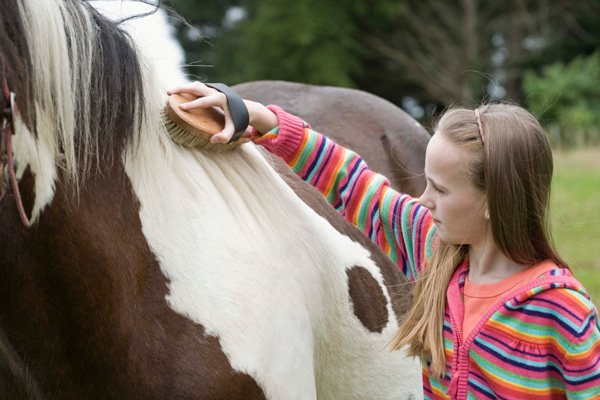 Credit: Thinkstock An abundance of fresh grass can be a danger to grazing horses.
Credit: Thinkstock An abundance of fresh grass can be a danger to grazing horses.After a long hard winter, every horse owner is happy to see the fields turn green as pasture forage begins to grow. It seems that it takes only a few sunny days for a grazing area to transform from acres of brown, dormant grass to a velvety green carpet of lush foliage. Turned out on this new growth, horses waste no time in eating their way though the delicious shoots.
Unfortunately, this abundance of fresh grass can be a danger to grazing horses. Although it is a natural food of equines, cool-season grass contains fructans, a storage form of nonstructural carbohydrates. Most sugars and starches are easily digested in the horse’s small intestine, but this is not the case for fructans. These carbohydrates pass undigested into the cecum and colon, causing shifts in the microbial population, upsetting hindgut pH, and producing endotoxins. In many horses, this cascade of events leads to laminitis, an intensely painful and crippling condition of structures within the horse’s hooves. For particularly sensitive horses, even a small amount of fructan-rich grass can quickly trigger laminitis that can be severe enough to require euthanasia.
Morgans, Quarter Horses, Tennessee Walking Horses and many pony breeds seem to be more susceptible than other horses to fructan-caused problems, but it should be understood that no horse of any breed or type is guaranteed to be unaffected. All horses with unrestricted access to lush pasture can be at risk, even after years of grazing freely without consequences.
To avoid problems when turning horses out on spring pastures, limit grazing time to half-hour segments several times a day and gradually increase the number and length of these access periods. Continue to offer hay to horses turned out on fresh pasture, as the new grass contains high moisture levels and very little fiber. Use grazing muzzles to limit the amount of grass the horse can consume. Turn horses out in dry lots rather than confining them to stalls. Keep an eye on manure (cow-like manure consistency means the horses may be getting too much liquid from fresh grass and not enough fiber) and monitor hoof temperature (unusually warm hoof surfaces are danger signs). Take the horse off pasture and call the veterinarian if the horse shows signs of hoof discomfort like reluctance to move, shifting from one foot to another, or assuming a leaning-back posture.
Laminitis is a serious and potentially life-ending ailment, so preventing it is far preferable to treating the condition. Managing horses to limit access to spring grass might be time-consuming, but it’s in the best interests of equines and their owners.
For free nutrition consultations visit Kentucky Equine Research.


